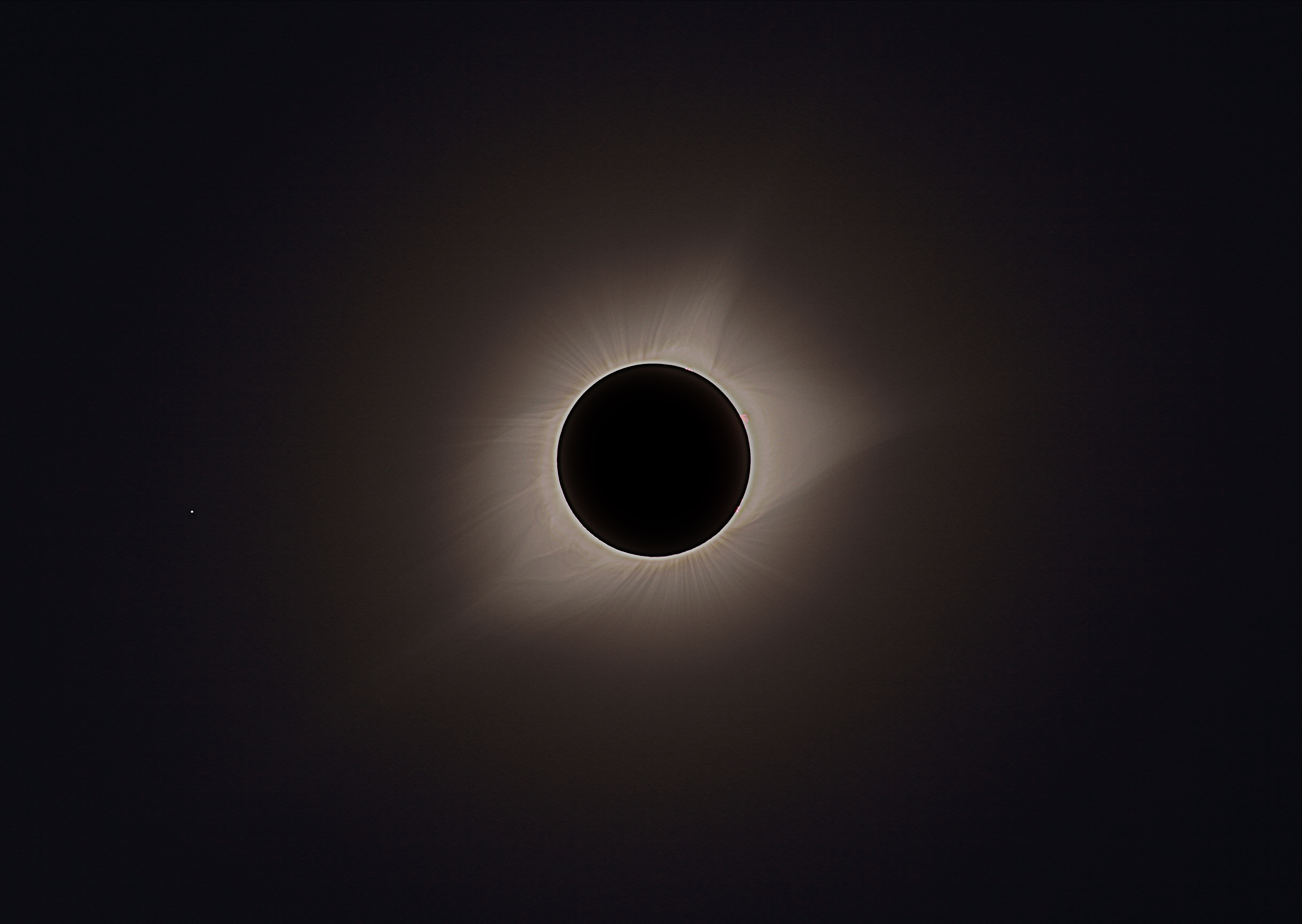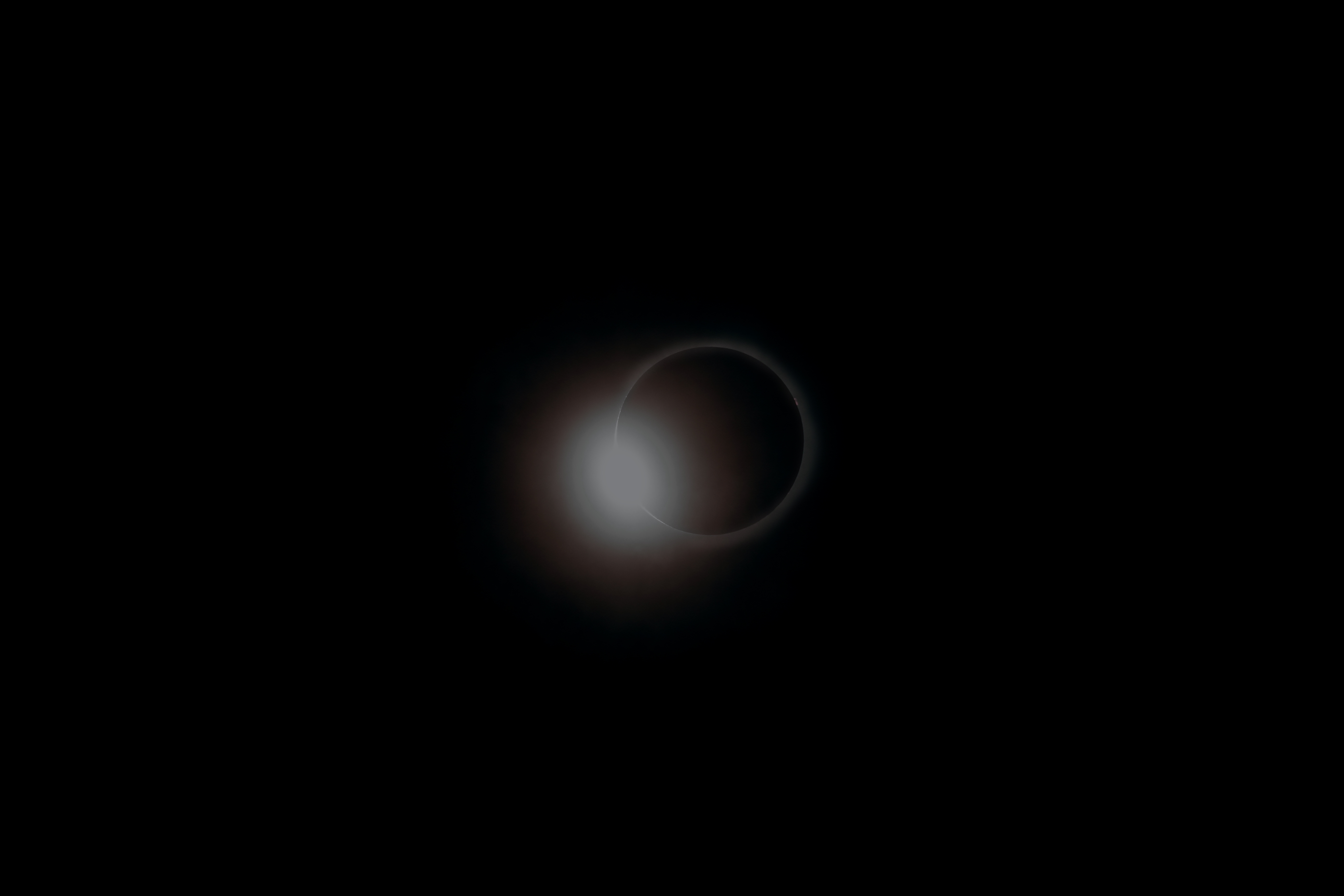Total Solar Eclipse August 21, 2017
HDR Image of the eclipsed Sun. Regulus is to the left of the Sun.
This image of the “Diamond Ring” was affected by the high cirrus clouds
This image shows the solar prominences that were visible naked eye.
The eclipse I witnessed on March 7, 1970 was an exciting event, with the moon covering 99% of the Sun. It was one of my life experiences that cemented my love for Astronomy. As a 12 year old, I constructed my first astronomical instrument, a pin hole box, to watch the moons shadow cross in front of the Sun.
Since that day, long ago, I hoped, one day, to be under the shadow of totality. On August 21st that hope became a reality. The Total Solar Eclipse on August 21st was an awe inspiring event. In anticipation of the eclipse I watched several youtube videos to experience the reactions of others who had viewed totality. I couldn’t help but tear up watching the videos as the excitement grew in me. I was not disappointed.
My home in South Carolina is only 5 minutes outside the path of totality, but the inconsistent summer weather here made me rethink my plans. When the Astronomical League decide to have their annual conference the weekend before the event, in Casper Wyoming, a place almost guaranteed to have clear weather, the choice was clear. I signed up for the conference and secured my room reservation more than two years before the eclipse.
It would be unfair to leave my non-astronomy wife home while I took my first cross country trip, so we incorporated our eclipse plans into a month long cross country trip. It would be our first, and we planned to visit friends, family, places of interest for my wife, as well as the eclipse, conference, and visits to some of the National Parks that would be of interest to us both.
I made plans to attempt to image the eclipse, practiced them, and modified them right up to the day before we left on vacation. My wife, an expert at vacation planning, took care of our day to day travel and visiting plans before and after the eclipse.
I wanted to image the eclipse without having to get so involved with the equipment that I would miss out on the visual experience. I decided I would use one of my computerized imaging programs, Backyard EOS, to run my DSLR, so my only involvement would be to remove the filter, push the button to start the imaging, and remember to replace the filter after totality. The BYEOS program would take about 4 seconds to download each image, limiting the number of images I could capture. But to me, the imaging was a secondary goal.
Along with the DSLR and BYEOS, I used my Ioptron ZEQ25gt mount, with my Stellarvue 60mm APO doublet to capture the images. The program was setup to capture frames from 1/2000 of a second to one second, and back up during the 2 minutes and 27 seconds of totality. I made several practice runs to time out the sequence with the length of totality.
On the day before the eclipse, in the hotel parking lot, I practiced my customized method of daytime alignment to make sure everything was good to go. My method included a wooden dovetail, compass, and info on the magnetic deviation for Casper Wyoming. Because the metal mount would cause havoc with the compass, the wooden dovetail extended about a foot behind the mount, where I could get an accurate reading. Along with my gps app, I was able to get very close to the pole. I did a solar system alignment on the Sun with the ZEQ25, and the Sun’s image was in the finder. I then adjusted the mount manually to center the Sun and finish the alignment. This worked perfectly, as the mount tracked for over two hours with the Sun only moving half its diameter on the cmos chip of the DSLR.
The viewing location for the eclipse was setup by the Astro League for all the attendees in agreement with Casper College, which was about 5 miles south of town, and very close to the center line. Because of the huge number of people that came to Casper for the conference and the eclipse, we started to head out early, in case we got caught in traffic. We left the hotel at 5:30 a.m. to beat traffic and there wasn’t a soul on the road. We found a great place on the grass between the parking lot and the road, and setup the equipment.
Then, Murphy’s law took over. I went through my process to align, but when I went to do a solar system alignment, the Sun wouldn’t appear in the list. I checked everything, including the time zone, DST, etc., but couldn’t get the Sun to appear in the routine. I ended up just doing a goto to the Sun and then adjusted the mount manually to center the Sun. I didn’t know if this would work, but it worked well enough that I only had to re-center the Sun on the chip every 15-20 minutes. The only explanation I could figure out for the problem was the proximity of the high tension wires overhead. Perhaps electrical interference played havoc with the built in GPS on the mount.
Whatever it was, I was able to overcome it, and got some decent images in the end. The only other imaging issue was the high cirrus clouds that moved in as totality approached. You can see in the images some of the haze and gradient issues I had while trying to process them. This was my first attempt at processing solar eclipse images, so I’m content with the results I was able to achieve.
Visually viewing the eclipse was one of the most inspiring astronomical events in my lifetime! After starting the imaging program, I looked up to see the brilliant diamond ring as the moon swallowed up the last of the sunlight. I described it as a 1000 watt light bulb shining on a diamond. This was followed by the amazing clarity and detail in the corona, with brilliant extended streamers on both sides. The corona, shaped by the Sun’s magnetic field stretched for multiple radii. It was exactly the shape predicted by NASA and depicted in one of the talks By Fred Espenak at the conference. I noticed Venus to the west of the Sun and picked up the binoculars to look for Regulus, which I found just to the east of the Sun. After putting down the binoculars I returned my gaze to the Sun and picked up the bright pink bumps of prominences at 12, 2, and 3 O’clock on the Sun’s limb. These were surprisingly easy to see.
As the Sun’s light returned, I stated out loudly, like many before me, “When is the next one!”



